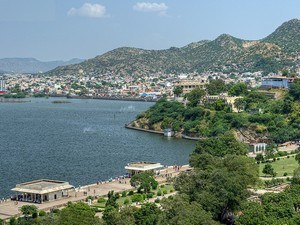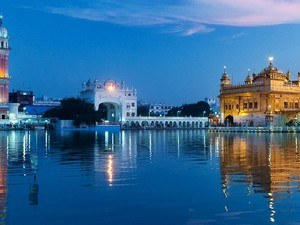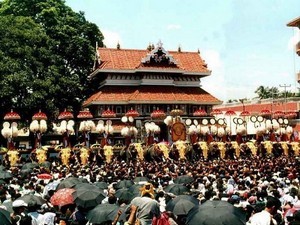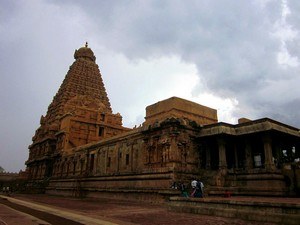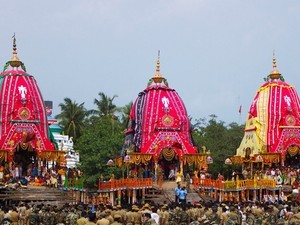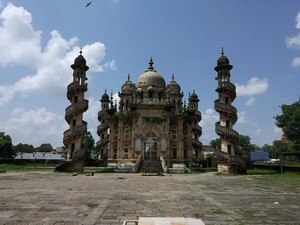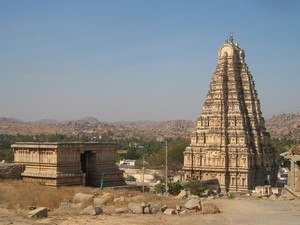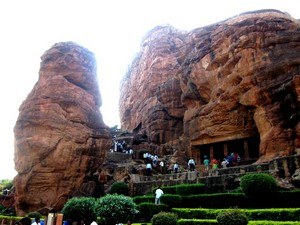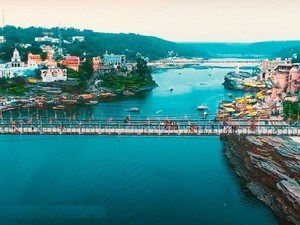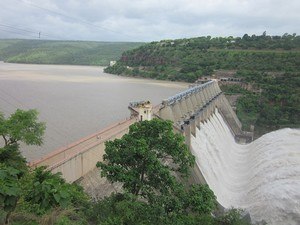1
DAY 1 : TRAVEL TO ALAMPUR & SIGHTSEEING
DAY 1 : TRAVEL TO ALAMPUR & SIGHTSEEING
 Sightseeing
Sightseeing
Leisure / No Sightseeing
At a distance of 1 km from Alampur Bus Station, Kudala Sangameswara Temple is the most magnificent of the temples at Alampur. It was built in 740 AD by Chalukya ruler Pulakesi II.
The temple was originally located at the point where Tungabhadra and Krishna Rivers were merged, 10 kms away from the current site. The temple was dismantled and built exactly rock-to-rock in the current site in 1979, as the original site was getting submerged due to the construction of Srisailam Dam.
The Sangameswara Temple is a wonderful structure with beautiful carvings on all corners. Built in Nagara style, the temple is built on an elevated platform with fortified wall around the temple. The temple has got large hall with 12 pillars followed by the sanctum. There is a circumambulatory path around the sanctum for pradakshinas. The ceiling has a large relief of Nagaraja, as seen in other .....
 Duration of visit: 30 Mins
Duration of visit: 30 Mins
 Timings: 8 AM to 6 PM
Timings: 8 AM to 6 PM
At a distance of 2 kms from Alampur Bus Station, Papanasi Temples are a group of wonderful temples dedicated to Lord Shiva. These temples are known for beautiful carvings.
Originally built on the banks of Tungabhadra River, the temples were moved to the current location during the construction of Srisailam Dam. The group of 24 temples were developed between 6th and 10th centuries. The main shrine called Papanaseswara was built by Chalukyas in the 6th century while the remaining temples were constructed by Rashtrakutas between 9th and 10th centuries. Built in Dravida and Phamsana styles, the site has two main temples and remaining are sub-shrines.
The main shrine of Papanaseswara has a large pillared mandapa and sanctum with Shivalinga. There are sub-shrines of Ganesha and Saptamatrukas on each side. The important art work in this temple includes Vamana avatara, Ashtadikpalakas, Mahishasura Mardhini, Ramayana scenes, .....
 Duration of visit: 30 Mins
Duration of visit: 30 Mins
 Timings: 8 AM to 6 PM
Timings: 8 AM to 6 PM
At a distance of 1 km from Alampur Bus Station, Bala Brahma Temple or Bala Brahmeswara Temple near Jogulamba Temple is the largest and most striking temple of the Navabrahma group of temples. This is the only temple where majority of the sculptures are found in good shape.
Built in 7th century by Chalukya ruler Pulakesi II, the temple had several additions during Vikramadita period in 755 AD. Constructed in Nagara style, there temple has large pillared varandah on all sides for outer pradakshinas. The temple has large mukha mandapa, mahamandapa and sanctum with circumambulatory path for inner pradakshinas. The shivalinga in this shrine is seen in the shape of a bull's footprint.
The doorway of inner sanctum has Dwarapalakas, Lion images along with Goddess Lakshmi, Ardhanareeswara, Vinayaka, Kalabhairava, etc. The inner mandapa has engraved figures of Mahishasura mardhini, Saptamatrukas, Indra and Agni along with a large dancing Shiva on the ceiling. The pillar has Yogamurthi .....
 Duration of visit: 30 Mins
Duration of visit: 30 Mins
 Timings: 8 AM - 1 PM & 3 PM - 8 PM
Timings: 8 AM - 1 PM & 3 PM - 8 PM
At a distance of 1 km from Alampur Bus Station, Garuda Brahma Temple is situated towards southern side of Bala Brahma Temple.
Built in Nagara style on an elevated platform, the temple has a small mukhamandapa, a large mahamandapa with 18 pillars and a sanctum with circumambulatory path. The ceiling of the mahamandapa has carving of Nagabandha with seven heads. The doorway of the sanctum has Garuda, Ganga and Yamuna. Above the doorway, there is an image of Brahma performing penance. The round pillars of the hall have floral designs and human figures. There is a small nandi installed in the mahamandapa facing the sanctum.
The four-pillared mukhamandapa is accompanied by dwarapalakas. The outer walls have carvings of Toranas, Warriors, Gandharvas and Nagas. The sukhanasi has a round circle, probably left incomplete.
Garuda Brahma Temple can be approached from the path on southern corridor of Bala Brahma Temple. There are several shrines housed in mandapa on northern side .....
 Duration of visit: 5 Mins
Duration of visit: 5 Mins
 Timings: 8 AM to 6 PM
Timings: 8 AM to 6 PM
At a distance of 1 km from Alampur Bus Station, Jogulamba Temple dedicated to Shakti is the prime religious attraction of Alampur. Being the 5th Maha Shaktipeeta, this place is highly regarded and very important religious site for Hindus. Situated past Balabrahma Temple, this temple was destroyed by Bahamani sultan in 14th century and the deity was moved to Balabrahma temple. The current structure was built in 2005 on original site and the deity was moved back to the temple. Adi Sankaracharya installed Srichakra in the original temple in 8th century which could not be recovered after destruction.
The temple complex has a main entrance with a tower, large open area followed by the main shrine. The main structure is built on an elevated platform with a large mandapa followed by the inner sanctum. Constructed in Nagara style, the architecture of original temple is followed to build this temple. There is a large water pool around the temple.
Jogulamba .....
 Duration of visit: 30 Mins
Duration of visit: 30 Mins
 Timings: 8 AM - 1 PM & 3 PM - 8 PM
Timings: 8 AM - 1 PM & 3 PM - 8 PM
At a distance of 1 km from Alampur Bus Station, Swarga Brahma Temple is a wonderful temple situated behind Bala Brahma Temple. This temple has extensive art work on the wall and pillars. Several figures were demolished during the attack in 14th century.
Built on an elevated platform, the temple has a small mukhamandapa, large pillared mahamandapa and a sanctum. There is a nandi statue installed an elevated platform opposite to the shrine. The sanctum has a circumambulatory path for pradakshinas. Built in nagara style, the vimana over sanctum has well preserved tower.
The doorway of the sanctum has figures of Ganga, Yamuna with their vehicles along with Nagendra. The circumambulatory path has images of Ganesha, Nagendra, Subrahmanya, Ducks and Lotus flowers. The ceiling of the mahamandapa has Nagabandha. The pillars have several engraved human figures. Some of these figures represent men riding lion and few mythical animals. There are statues of Ganesha, Maharshis spread in .....
 Duration of visit: 15 Mins
Duration of visit: 15 Mins
 Timings: 8 AM to 6 PM
Timings: 8 AM to 6 PM
At a distance of 1 km from Alampur Bus Station, Kumara Brahma Temple is situated toward southern side of Arka Brahma Temple, exactly opposite to the museum.
Built in Nagara style, this temple is built on a high elevated platform. This shrine possesses few wonderful sculptures on the pillars. The temple has a mukhamandapa with four pillars followed by the mahamandapa and inner sanctum with circumambulatory path.
There is an image of lord Vishnu on the doorway of the sanctum along with floral Toranas. The doorway is also decorated with Ganga, Yamuna and Nagendra. The pillars inside the mahamandapa have beautiful carvings of Gajalakshmi, Umamaheswara, Kubera, Elephants, Swans, Human riding mythical animals, etc. There is a sculpture of Saptamatrukas placed in the mahamandapa.
The pillars of mukhamandapa have wonderfully carved figures of Gandharvas, Kubera, Vinayaka, Celestial couples, Toranas and floral designs. The doorway of the mukha mandapa has seven female heads .....
 Duration of visit: 15 Mins
Duration of visit: 15 Mins
 Timings: 8 AM to 6 PM
Timings: 8 AM to 6 PM
At a distance of 1 km from Alampur Bus Station, Arka Brahma Temple is situated on southern side of Vira Brahma Temple. It was built by Chalukya ruler Vikramaditya I in 7th century.
Built in Nagara style, the vimana of the temple was destroyed during Bahamani Sultan attack in 14th century. The shrine has a mahamandapa followed by the sanctum with circumambulatory path. Appears plain outside, the temple has several sculptures scattered inside the mahamandapa. The doorway of the sanctum was recently built as the original one was destroyed.
The Shivalinga inside the sanctum has a Naga image which is a unique feature. The pillars in mahamandapa are square and plain. There is a Nandi installed opposite to the sanctum in mahamandapa. Majority of the sculptures on outer walls of this temple were destroyed while few sculptures like Ashtadikpalakas are stored in the museum.
 Duration of visit: 5 Mins
Duration of visit: 5 Mins
 Timings: 8 AM to 6 PM
Timings: 8 AM to 6 PM
At a distance of 1 km from Alampur Bus Station, Vira Brahma Temple is situated on southern side of Vishwa Brahma Temple.
Built in nagara style, the temple has an eight pillared hall followed by the sanctum along with circumambulatory path around sanctum. The doorway is accompanied by Ganga, Yamuna and Nagas. There is a nice carving of Shiva and Parvathi above the doorway of the sanctum. The ceiling of the mahamandapa has Nagabandha and lotus which is a common pattern here. The pillars in the hall are plain and square without any carvings.
The doorway of main entrance has Dwarapalakas and Gandharvas. The outer walls of the shrine have miniature temple brackets. There are several carvings of warriors on the outer walls. One of the images here represents a warrior fighting with two opponents. There are also several figures of celestial couples on the walls.
There is a Nandi installed in the hall opposite to the sanctum which has a pendent of Shivalinga in the neck.
 Duration of visit: 5 Mins
Duration of visit: 5 Mins
 Timings: 8 AM to 6 PM
Timings: 8 AM to 6 PM
At a distance of 1 km from Alampur Bus Station, Vishwa Brahma Temple is the best preserved temple after Bala Brahma temple among Navabrahma temples. This temple hosts wonderful carvings throughout the structure.
Situated towards northern corner opposite to the museum beside Vira Brahma temple, architecture of this temple resembles that of Galaganatha Temple in Pattadakal. The temple boasts a large mahamandapa with 18 pillars followed by the sanctum. Built on an elevated platform, there is no mukhamandapa in this temple. Inner sanctum has a circumambulatory path for pradakshinas. The sanctum is supported by four pillars with carvings of Ramayana scenes, Gandharvas, Lions, etc. The ceiling has wonderful carvings of Nagabandha and lotus. The doorway of the sanctum has images of Gajalakshmi, Ganga and Yamuna along with their vehicles Crocodile and Tortoise.
The circumambulatory path around sanctum has few good images of ducks with two heads. The pillars in the mahamandapa have .....
 Duration of visit: 15 Mins
Duration of visit: 15 Mins
 Timings: 8 AM to 6 PM
Timings: 8 AM to 6 PM
At a distance of 1 km from Alampur Bus Station, Archeology Museum situated at the entrance of the Bala Brahma Temple complex houses wonderful collection of sculptures and inscriptions recovered from the Navabrahma Temples and surroundings of Alampur.
Started in 1953 by then Vice President of India Sarvepalli Radhakrishnan, the museum consists of 188 sculptures and 2 inscriptions. These artifacts are dated between 6th and 16th centuries. The museum is a large hall with an open air section at the center and a small enclosure towards the eastern side. All the artifacts are spread across the hall.
Some of the important sculptures in the museum include 7th century Surya, Nataraja, Lord Vishnu, Subrahmanya with Valli, Siva & Parvathi riding on Nandi, Saptamatrukas, Nagabandhas, Mahishasura mardhini, Nagnanaka Bandha, Ashtadikpalakas, Nagas among others. The Surya sculpture, one of the Nataraja figures along with a Mahishasura mardhini .....
 Duration of visit: 30 Mins
Duration of visit: 30 Mins
 Timings: 10:30 AM to 1 PM and 1:30 PM to 5 PM
Timings: 10:30 AM to 1 PM and 1:30 PM to 5 PM
2
DAY 2 : VISIT ORVAKAL - YAGANTI & TRAVEL TO HYDERABAD
%%Itinerary_Title_Day2%%
 Sightseeing
Sightseeing
At a distance of 23 km from Kurnool, 53 km from Nandyal, 45 km from Alampur, 56 km from Yaganti, 70 km from Mahanandi & 237 km from Hyderabad, Orvakal Rock Garden (also known as Orvakallu) is a wonderful site with abundant natural beauty of rock formations. It is situated on Kurnool - Nandyal highway at a distance of 3 km from Orvakal village.
Orvakal Rock Garden is a rare silica and quartz rock formation site with beautiful surroundings. The rocks are formed around a natural lake in the middle of the site that enhances the beauty of the place. This is one of the must visit places in the surrounding of Kurnool. The rocks are spread across an area of 50 acres adjacent to Kurnool - Nandyal highway.
The garden is well developed by AP Tourism with a restaurant at the entrance and cottages spread across the garden. There is a walkway built .....
 Duration of visit: 1 Hour
Duration of visit: 1 Hour
 Timings: 9 AM to 6 PM
Timings: 9 AM to 6 PM
At a distance of 300 meters from Yaganti Bus Stand, Pushkarini is the famous temple pond of Yaganti situated about 100 meters before the main temple entrance.
Pushkarini, filled with pure water throughout the year, is a wonderful structure with beautiful gopuras, pillared corridor and wonderfully built a mandapa at the center of the pond. No one knows how the water flows into Pushkarini in all the seasons. The water flows continuously keeping the water in the pond clean all the time. The water flows through a rock entrance with carved figures of Nandi. Devotees usually take bath in the pushkarini before visiting the main temple.
There are wonderful carvings of Lord Shiva, Lingodbhava, Lord Vishnu, Shiva & Parvathi and several other gods below the first step of the temple pond.
 Duration of visit: 15 Mins
Duration of visit: 15 Mins
 Timings: 6 AM to 8 PM
Timings: 6 AM to 8 PM
At a distance of 400 meters from Yaganti Bus Stand, Uma Maheshwara Swamy (also called Yagantiswamy) Temple is an ancient temple dedicated to Lord Shiva.
Yaganti is one of the most famous Shiva Temple is Andhra Pradesh state. The temple dates back to 5th and 6th centuries with contributions from Pallavas, Cholas, Chalukyas and Vijayanagara rulers. The temple received significant contribution from Vijayanagara Kings Harihara & Bukka Rayalu, who finished the construction of several structures in and around the temple.
Built in Dravida style, the temple boasts a large five-story tower built by Vijayanagara rulers. The tower is followed by the main temple structure built with stone which has a large pillared hall followed by the sanctum which houses the deity. The pillars in front of the sanctum have wonderful carvings of Lord Shiva, Vishnu and Brahma along with several other gods.
The sancutm houses the idol of Shiva & Parvathi .....
 Duration of visit: 1-2 Hours
Duration of visit: 1-2 Hours
 Timings: 6 AM - 1 PM and 3 PM - 8 PM
Timings: 6 AM - 1 PM and 3 PM - 8 PM
At a distance of 500 meters from Yaganti Bus Stand and 200 meters from Uma Maheshwara Temple, Agasthya Guha (cave), also known as Rokalla Guha is the cave where Sage Agastya performed the Penance for Lord Shiva. It is situated on eastern side of Venkateswara Guha.
While travelling in South India, Sage Agastya came across this place and he wanted to build a temple for Lord Venkateswara. However, the statue that was made could not be installed as the toe nail of the deity got broken. Sage Agastya was upset over this and he performed a penance for Lord Shiva. When Lord Shiva appeared, he asked the Lord the reason why he could not install Lord Venkateswara statue. Lord Shiva replied that the place suits Shiva better as the hills resemble Kailasha. Agastya then requested Lord Shiva to give the darshan to devotees along with Goddess Parvathi as Uma Maheswara in a single stone, which Lord Shiva obliged.
This cave can be reached by climbing very steep steps. There is a Shivalinga at .....
 Duration of visit: 30 Mins
Duration of visit: 30 Mins
 Timings: 6 AM to 1 PM & 3 PM to 6 PM
Timings: 6 AM to 1 PM & 3 PM to 6 PM
At a distance of 400 meters from Yaganti Bus Stand and 100 meters from Uma Maheshwara Temple, Venkateswara Guha (cave) has a damaged idol of Lord Venkateswara. This is said to be the idol made by Sage Agastya in order to build Venkateswara temple at this place.
Another story says that, first lord Venkateswara is placed in this cave instead of Tirupati. But as the idol has damaged feet, it could not be worshipped. As per Veera Brahmam Kala Gynanam, whenever people cannot worship god in Tirupati, then this place is going to be alternative instead of Tirupati. Lord Venkateswara is worshipped here and the original idol of the deity can also be seen. This place gets crowded in peak season, Saturdays and Shivaratri season.
This cave can be reached by climbing very steep steps from the gopura of Uma Maheshwara Temple. The cave also boasts enormous natural beauty.
Timings: 6 AM - 1 PM and 3 PM - 6:30 PM
 Duration of visit: 30 Mins
Duration of visit: 30 Mins
 Timings: 6 AM to 1 PM & 3 PM to 6 PM
Timings: 6 AM to 1 PM & 3 PM to 6 PM

